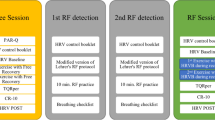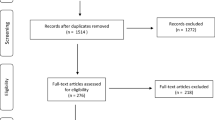Abstract
Support and management staff in elite sport experience work-related stress and emotional disturbance to a similar extent as athletes (Fletcher and Wagstaff 2009). The resonant frequency breathing technique (Lehrer et al. 2000) can inhibit autonomic changes associated with stressful situations or events and as such provides a potential emotional regulation tool. The present study utilised five practitioner-led heart rate variability (HRV) biofeedback sessions and home practice via mobile applications to train support and management staff (n = 9) in resonant frequency breathing techniques. Although baseline HRV did not change from pre to post training, participants increased total HRV (i.e., SDNN; p = .006), parasympathetic HRV (i.e., RMSSD; p = .028) and HRV reflective of baroreflex function (i.e., low frequency power; p = .018) while accurately performing resonant frequency breathing without a breath pacer. Post-intervention questionnaire data revealed an increase (p = .032) in habitual use of somatic strategies for emotional regulation, and social validation data suggested that the technique enhanced emotional regulation at home, work and during international competition. HRV biofeedback and the resonant frequency technique provided an on-demand emotional regulation technique for elite sport support and management staff.

Similar content being viewed by others
References
Appelhans, B. M., & Luecken, L. J. (2006). Heart rate variability as an index of regulated emotional responding. Review of General Psychology, 10, 229–240. doi:10.1037/1089-2680.10.3.229.
Arnold, R., Fletcher, D., & Molyneux, L. (2012). Performance leadership and management in elite sport: Recommendations, advice and suggestions from national performance directors. European Sport Management Quarterly, 12, 317–336. doi:10.1080/16184742.2012.693115.
Arnold, R., & Sarkar, M. (2015). Preparing athletes and teams for the Olympic Games: Experiences and lessons learned from the world’s best sport psychologists. International Journal of Sport and Exercise Psychology, 13, 4–20. doi:10.1080/1612197X.2014.932827.
Bertsch, K., Hagemann, D., Naumann, E., Schachinger, H., & Schulz, A. (2012). Stability of heart rate variability indices reflecting parasympathetic activity. Psychophysiology, 49, 672–682. doi:10.1111/j.1469-8986.2011.01341.x.
Bond, F. W., & Bunce, D. (2003). The role of acceptance and job control in mental health, job satisfaction, and work performance. Journal of Applied Psychology, 88, 1057–1067. doi:10.1037/0021-9010.88.6.1057.
Bradley, R. T., McCraty, R., Atkinson, M., Tomasino, D., Daugherty, A., & Arguelles, L. (2010). Emotion self-regulation, psychophysiological coherence, and test anxiety: Results from an experiment using electrophysiological measures. Applied Psychophysiology and Biofeedback, 35, 261–283. doi:10.1007/s10484-010-9134-x.
Cotton, P., & Hart, P. M. (2003). Occupational wellbeing and performance: A review of organisational health research. Australian Psychologist, 38, 118–127. doi:10.1080/00050060310001707117.
Critchley, H. D., & Nagai, Y. (2012). How emotions are shaped by bodily states. Emotion Review, 4, 163–168. doi:10.1177/1754073911430132.
Duschek, S., Worsching, J., & Reyes Del Paso, G. A. (2013). Interactions between autonomic cardioascular regulation and cortical activity: A CNV study. Psychophysiology, 50, 388–397. doi:10.1111/psyp.12026
Fletcher, D., & Scott, M. (2010). Psychological stress in sports coaches: A review of concepts, research, and practice. Journal of Sport Sciences, 28, 127–137. doi:10.1080/02640410903406208.
Fletcher, D., & Wagstaff, C. R. (2009). Organizational psychology in elite sport: Its emergence, application and future. Psychology of Sport and Exercise, 10, 427–434. doi:10.1016/j.psychsport.2009.03.009.
Force, Task. (1996). Heart rate variability: Standards of measurement, physiological interpretation and clinical use. Circulation, 93, 1043–1065.
Gevirtz, R. (2013). The promise of heart rate variability biofeedback: Evidence-based applications. Biofeedback, 41, 110–120. doi:10.5298/1081-5937-41.3.01.
Goldstein, D. S., Bentho, O., Park, M. Y., & Sharabi, Y. (2011). Low-frequency power of heart rate variability is not a measure of cardiac sympathetic tone but may be a measure of modulation of cardiac autonomic outflows by baroreflexes. Experimental Physiology, 96, 1255–1261. doi:10.1113/expphysiol.2010.056259.
Gray, M. A., Beacher, F. D., Minati, L., Nagai, Y., Kemp, A. H., Harrison, N. A., & Critchley, H. D. (2011). Emotional appraisal is influenced by cardiac afferent information. Emotion, 12, 180–191. doi:10.1037/a0025083.
Gross, J. J., & John, O. P. (2003). Individual differences in two emotion regulation processes: Implications for affect, relationships, and well-being. Journal of Personality and Social Psychology, 85, 348–362. doi:10.1037/0022-3514.85.2.348.
Heathers, J. A. (2013). Smartphone-enabled pulse rate variability: An alternative methodology for the collection of heart rate variability in psychophysiological research. International Journal of Psychophysiology, 89, 297–304. doi:10.1016/j.ijpsycho.2013.05.017.
Hopkins, W. A. (2007). A spreadsheet for deriving a confidence interval, mechanistic inference and clinical inference from a p value. Sportscience, 11, 16–20.
Hopkins, W. G., Marshall, S. W., Batterham, A. M., & Hanin, J. (2009). Progressive statistics for studies in sports medicine and exercise science. Medicine and Science in Sports and Exercise, 41, 3–12. doi:10.1249/MSS.0b013e31818cb278.
Karavidas, M. K., Lehrer, P. M., Vaschillo, E., Vaschillo, B., Marin, H., Buyske, S., & Hassett, A. (2007). Preliminary results of an open label study of heart rate variability biofeedback for the treatment of major depression. Applied Psychophysiology and Biofeedback, 32, 19–30. doi:10.1007/s10484-006-9029-z.
Kleck, R. E., Vaughan, R. C., Cartwright-Smith, J., Vaughan, K. B., Colby, C. Z., & Lanzetta, J. T. (1976). Effects of being observed on expressive, subjective and physiological responses to painful stimuli. Journal of Personality and Social Psychology, 34, 1211–1218. doi:10.1037/0022-3514.34.6.1211.
Kleiger, R. E., Stein, P. K., & Bigger, J. T., Jr. (2005). Heart rate variability: Measurement and clinical utility. Annals of Noninvasive Electrocardiology, 10, 88–101. doi:10.1111/j.1542-474X.2005.10101.x.
Laborde, S., Brüll, A., Weber, J., & Anders, L. S. (2011). Trait emotional intelligence in sports: A protective role against stress through heart rate variability? Personality and Individual Differences, 51, 23–27. doi:10.1016/j.paid.2011.03.003.
Laborde, S., Raab, M., & Kinrade, N. (2014). Is the ability to keep your mind sharp under pressure reflected in your heart? Evidence for the neurophysiological bases of decision reinvestment. Biological Psychology, 100, 34–42. doi:10.1016/j.biopsycho.2014.05.003.
Lehrer, P. M., & Eddie, D. (2013). Dynamic processes in regulation and some implications for biofeedback and biobehavioral interventions. Applied Psychophysiology and Biofeedback, 38, 143–155. doi:10.1007/s10484-013-9217-6.
Lehrer, P. M., & Gevirtz, R. (2014). Heart rate variability biofeedback: How and why does it work? Frontiers in Psychology, 5, 1–9. doi:10.3389/fpsyg.2014.00756.
Lehrer, P., Vaschillo, E., Lu, S. E., Eckberg, D., Vaschillo, B., Scardella, A., & Habib, R. (2006). Heart rate variability biofeedback: Effects of age on heart rate variability, baroreflex gain, and asthma. Chest, 129, 278–284. doi:10.1378/chest.129.2.278.
Lehrer, P. M., Vaschillo, E., & Vaschillo, B. (2000). Resonant frequency biofeedback training to increase cardiac variability: Rationale and manual for training. Applied Psychophysiology and Biofeedback, 25, 177–189.
Lehrer, P. M., Vaschillo, E., Vaschillo, B., Lu, S. E., Eckberg, D. L., Edelberg, R., & Hamer, R. M. (2003). Heart rate variability biofeedback increases baroreflex gain and peak expiratory flow. Psychosomatic Medicine, 65, 796–805.
Malliani, A. (1995). Association of heart rate variability components with physiological regulatory mechanisms. In M. Malik & A. J. Camm (Eds.), Heart rate variability (pp. 173–188). Armonk, NY: Futura Publishing.
McCann, S. (2008). At the Olympics, everything is a performance issue. International Journal of Sport and Exercise Psychology, 6, 267–276.
Notarius, C. F., & Floras, J. S. (2012). Caffeine enhance heart rate variability in middle-aged healthy, but not heart failure subjects. Journal of Caffeine Research, 2, 77–82. doi:10.1089/jcr.2012.0010.
Nunan, D., Sandercock, G. R., & Brodie, D. A. (2010). A quantitative systematic review of normal values for short-term heart rate variability in healthy adults. Pacing and Cardiac Electrophysiology, 33, 1407–1417. doi:10.1111/j.1540-8159.2010.02841.x.
Ochsner, K. N., & Gross, J. J. (2008). Cognitive emotion regulation. Insights from social cognitive and affective neuroscience. Current Directions in Psychological Science, 17, 153–158. doi:10.1111/j.1467-8721.2008.00566.x.
Paul, M., Garg, K., & Sandhu, J. S. (2012). Role of biofeedback in optimizing psychomotor performance in sports. Asian Journal of Sports Medicine, 3, 29–40.
Phillips, L. H., Salidias, A., Mccarrey, A., Henry, J. D., Scott, C., & Summers, F. (2009). Attentional lapses, emotional regulation and quality of life in multiple sclerosis. British Journal of Clinical Psychology, 25, 101–106. doi:10.1348/014466508X379566.
Porges, S. W. (2007). The polyvagal perspective. Biological Psychology, 74, 116–143. doi:10.1016/l.biopsycho.2006.06.009.
Prinsloo, G. E., Derman, W. E., Lambert, M. I., & Rauch, L. H. (2013). The effect of a single session of short duration biofeedback-induced deep breathing on measures of heart rate variability during laboratory-induced cognitive stress: A pilot study. Applied Psychophysiology and Biofeedback, 38, 81–90. doi:10.1007/s10484-013-9210-0.
Prinsloo, G. E., Rauch, L. H., Lambert, M. I., Muench, F., Noakes, T. D., & Derman, W. E. (2011). The effect of short duration heart rate variability (HRV) biofeedback on cognitive performance during laboratory induced cognitive stress. Applied Cognitive Psychology, 25, 792–801. doi:10.1002/acp.1750.
Quintana, D. S., Guastella, A. J., Outhred, T., Hickie, I. B., & Kemp, A. H. (2012). Heart rate variability is associated with emotion recognition: Direct evidence for a relationship between the autonomic nervous system and social cognition. International Journal of Psychophysiology, 86, 168–172. doi:10.1016/j.ijpsycho.2012.08.012.
Raio, C. M., Orederu, T. A., Palazzolo, L., Shurick, A. A., & Phelps, E. A. (2013). Cognitive emotion regulation fails the stress test. Proceedings of the National Academy of Sciences of the United States of America, 110, 15139–15144. doi:10.1073/pnas.1305706110.
Reyes Del Paso, G. A., Langewitz, W., Mulder, L. J., Van Roon, A., & Duschek, S. (2013). The utility of low frequency heart rate variability as an index of sympathetic cardiac tone: A review with emphasis on a re-analysis of previous studies. Psychophysiology, 50, 477–487. doi:10.1111/psyp.12027.
Reynard, A., Gevirtz, R., Berlow, R., Brown, M., & Boutelle, K. (2011). Heart rate variability as a marker of self-regulation. Applied Psychophysiology and Biofeedback, 36, 209–215. doi:10.1007/s10484-011-9162-1.
Saku, K., Kishi, T., Sakamoto, K., Hosokawa, K., Sakamoto, T., Murayama, Y., & Sunagawa, K. (2014). Afferent vagal nerve stimulation resets baroreflex neural arc and inhibits sympathetic nerve activity. Physiological Reports, 2, 1–12. doi:10.14814/phy2.12136.
Shaffer, F., McCraty, R., & Zerr, C. L. (2014). A healthy heart is not a metronome: an integrative review of the heart’s anatomy and heart rate variability. Frontiers in Psychology, 5, 1–19. doi:10.3389/fpsyg.2014.01040.
Sterne, J. A. C., & Smith, G. D. (2001). Sifting the evidence-what’s wrong with significance tests? British Medical Journal, 322, 226–231.
Sutarto, P. A., Wahab, N. A. M., & Zin, M. N. (2013). Effect of biofeedback training on operator’s cognitive performance. Work, 44, 231–234. doi:10.3233/WOR-121499.
Thayer, J. F., Ahs, F., Fredrikson, M., Sollers, J. J., I. I. I., & Wager, T. D. (2012). A meta-analysis of heart rate variability and neuroimaging studies: Implications for heart rate variability as a marker of stress and health. Neuroscience and Biobehavioral Reviews, 36, 747–756. doi:10.1016/j.neubiorev.2011.11.009.
Thayer, J. F., & Lane, R. D. (2000). A model of neurovisceral integration in emotion regulation and dysregulation. Journal of Affective Disorders, 61, 201–216. doi:10.1016/S0165-0327(00)00338-4.
Timson, S. (2006). Reflections on Athens: Delivering sport psychology at the BOA Cyprus holding camp. Sport and Exercise Psychology Review, 2, 20–24.
Wagstaff, C. R., Fletcher, D., & Hanton, S. (2012). Exploring emotion abilities and regulation strategies in sport organizations. Sport, Exercise and Performance Psychology, 1, 262–282.
Wagstaff, C. R., Hanton, S., & Fletcher, D. (2013). Developing emotion abilities and regulation strategies in a sport organization. Psychology of Sport and Exercise, 14, 476–487. doi:10.1016/j.psychsport.2013.01.006.
Wells, R., Outhred, T., Heathers, J. A. J., Quintana, D. S., & Kemp, A. H. (2012). Matter over mind: A randomised-controlled trial single-session biofeedback training on performance anxiety and heart rate variability in musicians. PLoS One, 7, 1–11. doi:10.1371/journal.pone.0046597.
Welsh, A. H., & Knight, E. J. (2015). “Magnitude-based inference”: A statistical review. Medicine and Science in Sports and Exercise, 47, 874–884. doi:10.1249/MSS.0000000000000451.
Acknowledgments
This research was supported by European Regional Development Fund (ERDF) and Welsh Government Academic Expertise for Business (A4B) funding. The authors would like to thank the performance science staff at Sport Wales for warmly welcoming project staff and continued cooperation. The authors would also like to thank the Welsh Elite Performance Sport Innovation Network (WEPSIN) for their time and expertise.
Author information
Authors and Affiliations
Corresponding author
Rights and permissions
About this article
Cite this article
Gross, M.J., Shearer, D.A., Bringer, J.D. et al. Abbreviated Resonant Frequency Training to Augment Heart Rate Variability and Enhance On-Demand Emotional Regulation in Elite Sport Support Staff. Appl Psychophysiol Biofeedback 41, 263–274 (2016). https://doi.org/10.1007/s10484-015-9330-9
Published:
Issue Date:
DOI: https://doi.org/10.1007/s10484-015-9330-9




